Tom's Hardware Verdict
The AMD RX 7600 hits the sweet spot with sub-$300 pricing but ultimately delivers similar performance as the previous generation RX 6650 XT. It's an okay card, but like most mainstream GPU launches, it doesn't bring anything truly new or revolutionary to the graphics card landscape — it's yet another 8GB and 128-bit solution.
Pros
- +
Compact design and understated appearance
- +
Works fine for 1080p gaming
- +
Reasonable $269 MSRP
- +
DisplayPort 2.1 and AV1 support
Cons
- -
Not much faster than RX 6650 XT, but for more money
- -
Last-gen TSMC N6 process node
- -
Some people like bling (but there are AIB cards for that)
- -
AMD's reference card runs a bit warm/loud
Why you can trust Tom's Hardware
The AMD Radeon RX 7600 brings the latest-generation RDNA 3 architecture to the sub-$300 realm. It may even qualify as a "budget" graphics card, depending on how you want to stretch that definition. Originally planned for a $299 launch price, AMD dropped the official RX 7600 MSRP to $269 over the past weekend, likely thanks to Nvidia's RTX 4060 $299 announcement. Numerous leaks over the past few weeks have already hinted at what we'll see today, but let's get to it.
Will the RX 7600 rank among the best graphics cards? We'll give it a resounding maybe. Ultimately, it will come down to street prices over the coming months. Right now, plenty of existing RX 6650 XT, RX 6600 XT, and RX 6600 cards largely fill the same role, but with lower pricing. Those originally had significantly higher MSRPs, thanks to the GPU shortages and mining that was going on in 2021–2022, but now you can pick up one of the XT models for under $250, and the vanilla RX 6600 starts at just $199.
What does the new RDNA 3 architecture bring to the party? Reworked compute units (CUs) with a big boost in theoretical number crunching prowess, improved FP16 (AI) functionality, and better silicon utilization, according to AMD. In addition to our normal gaming, power, and thermal tests, we also ran the card through some stable diffusion tests. Here's the overview of the specifications.
| Graphics Card | RX 7600 | RX 6650 XT | RX 6600 XT | RX 6600 | RX 6700 |
|---|---|---|---|---|---|
| Architecture | Navi 33 | Navi 23 | Navi 23 | Navi 23 | Navi 22 |
| Process Technology | TSMC N6 | TSMC N7 | TSMC N7 | TSMC N7 | TSMC N7 |
| Transistors (Billion) | 13.3 | 11.1 | 11.1 | 11.1 | 17.2 |
| Die size (mm^2) | 204 | 237 | 237 | 237 | 336 |
| CUs | 32 | 32 | 32 | 28 | 36 |
| GPU Cores (Shaders) | 2048 | 2048 | 2048 | 1792 | 2304 |
| AI Cores | 64 | N/A | N/A | N/A | N/A |
| Ray Accelerators | 32 | 32 | 32 | 28 | 36 |
| Boost Clock (MHz) | 2625 | 2635 | 2589 | 2491 | 2450 |
| VRAM Speed (Gbps) | 18 | 18 | 16 | 14 | 16 |
| VRAM (GB) | 8 | 8 | 8 | 8 | 10 |
| VRAM Bus Width | 128 | 128 | 128 | 128 | 160 |
| Infinity Cache | 32 | 32 | 32 | 32 | 80 |
| ROPs | 64 | 64 | 64 | 64 | 64 |
| TMUs | 128 | 128 | 128 | 112 | 144 |
| TFLOPS FP32 (Boost) | 21.5 | 10.8 | 10.6 | 8.9 | 11.3 |
| TFLOPS FP16 (FP8) | 43 | 21.6 | 21.2 | 17.8 | 22.6 |
| Bandwidth (GBps) | 288 | 288 | 256 | 224 | 320 |
| TDP (watts) | 165 | 180 | 160 | 132 | 175 |
| Launch Date | May 2023 | May 2022 | Aug 2021 | Oct 2021 | Mar 2021 |
| Launch Price | $269 | $399 | $379 | $329 | $479? |
| Online Price | $269 | $249 | $244 | $199 | $279 |
On paper, there appear to be some major upgrades. For example, the dual compute units have twice as many ALUs (arithmetic logic units) as before, so the RX 7600 has a massive increase in FP32 teraflops: 21.5 versus just 10.8 on the RX 6650 XT, or basically double the compute performance. FP16 throughput is also doubled.
That sounds good in theory, but in practice, the real-world gains seem to be far more limited. For example, the RX 7900 XT has 51.6 teraflops of FP32 while the RX 6950 XT only has 23.7, so a 118% increase in compute. In our benchmarks, particularly for games, the 7900 XT is about 20% faster on average. If the same pattern holds with Navi 33 (spoiler: it mostly does), gaming performance won't be significantly faster.
Elsewhere, you don't get any extra VRAM, and both the RX 7600 and RX 6650 XT use 18 Gbps GDDR6. Even the process node hasn't been radically altered, as TSMC's N6 is a refined variant of the N7 node used for Navi 23. Density did improve, though, from around 47 million transistors per square millimeter (Mtrans/mm^2) to 65 Mtrans/mm^2. However, that's still a far cry from the ~122 Mtrans/mm^2 that Nvidia is getting on its Ada Lovelace RTX 40-series GPUs, or the 152 Mtrans/mm^2 for the Navi 31 (RX 7900-series) GCD.
Besides doubling the maximum FP32/FP16 throughput from the shader cores, one of the biggest architectural changes with AMD's RDNA 3 architecture is the move to GPU chiplets. Except Navi 33 doesn't do that, sticking with a traditional monolithic die approach. That's not really surprising, as GPU chiplets are primarily about cost savings, and adding in extra interconnects between a GCD and multiple MCDs likely only makes sense with wider memory interfaces and stacked L3 caches.




AMD and Nvidia have similar marketing surrounding their new 8GB graphics cards. They're good for 1080p, and lots of people use that resolution (or lower). Where AMD and Nvidia diverge is in the particulars of some of the hardware, as well as memory configurations and pricing.
Nvidia has had tensor cores in its RTX GPUs since 2018, and these can help accelerate deep learning and AI workloads — they're part of the special sauce behind DLSS, for example. Nvidia has also put more effort into making fast ray tracing hardware.
In contrast, AMD has generally focused more on delivering improved rasterization performance, at least for comparable price points. There's also less proprietary hardware and APIs. AMD does have "AI Accelerators" in RDNA 3, which share the FP16 compute functionality of the shaders. They're not quite the same as the full-blown tensor core implementations found in AMD's CDNA/CDNA 2 architectures for data centers, but they do provide some optimizations in throughput compared to accessing the same hardware via shaders. (We'll see some of this in our Stable Diffusion testing later.)
Depending on what product tier you're looking at, AMD also offers potentially more memory. However, that's not the case with the RX 7600, as it's basically near the bottom of the RDNA 3 stack and comes with the same 128-bit interface and 8GB as Nvidia's RTX 4060 Ti and the upcoming RTX 4060. Of course, the RX 7600 also costs less than either of those. The mainstream and high-end AMD RDNA 3 solutions (for desktops) haven't been officially announced yet, but it looks like AMD will probably offer a 192-bit interface and 12GB of VRAM with the 7700-class parts, and then a 256-bit interface and 16GB of VRAM with 7800-class parts. We'll have to wait and see how those stack up in performance against Nvidia's offerings.


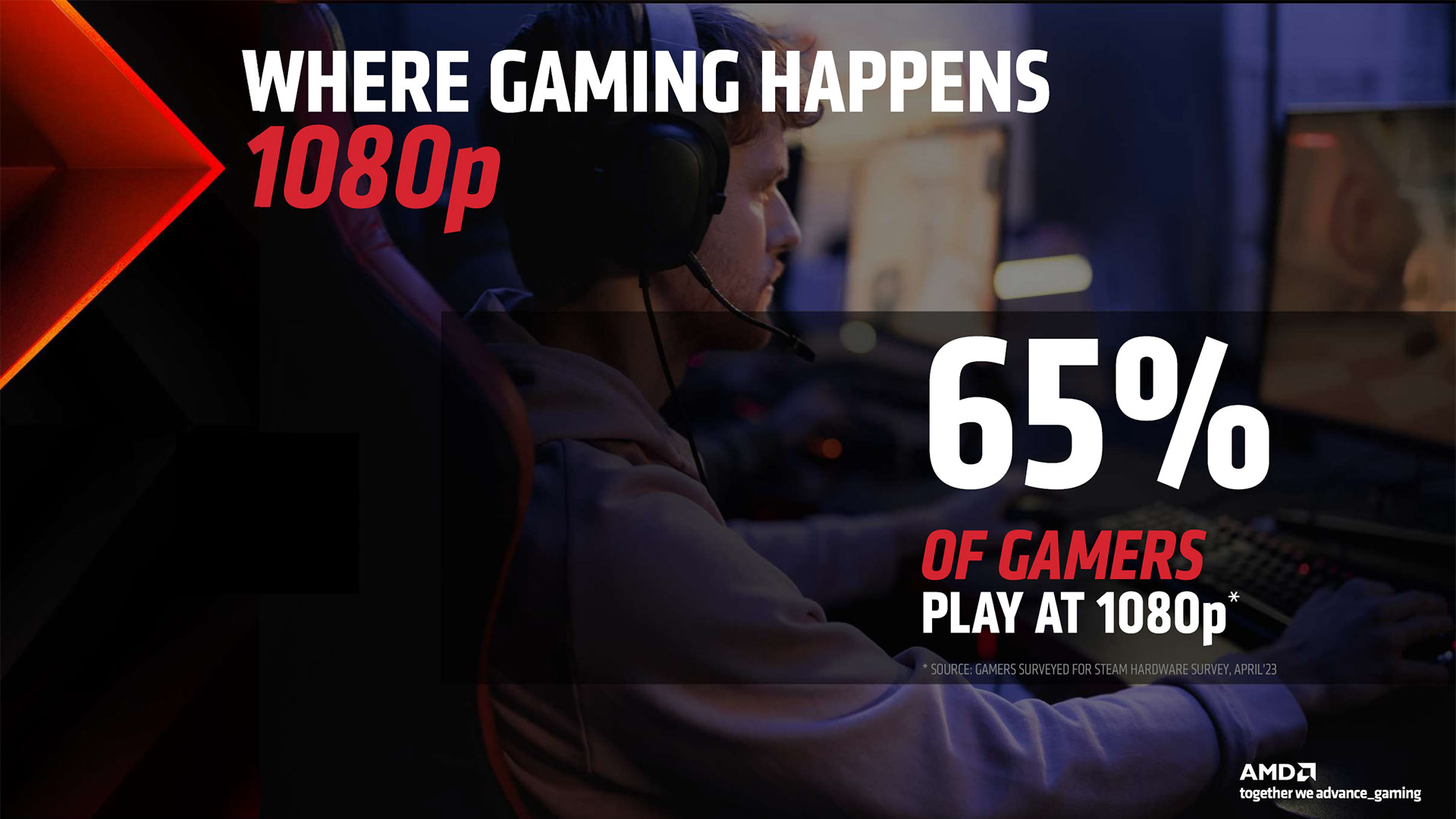



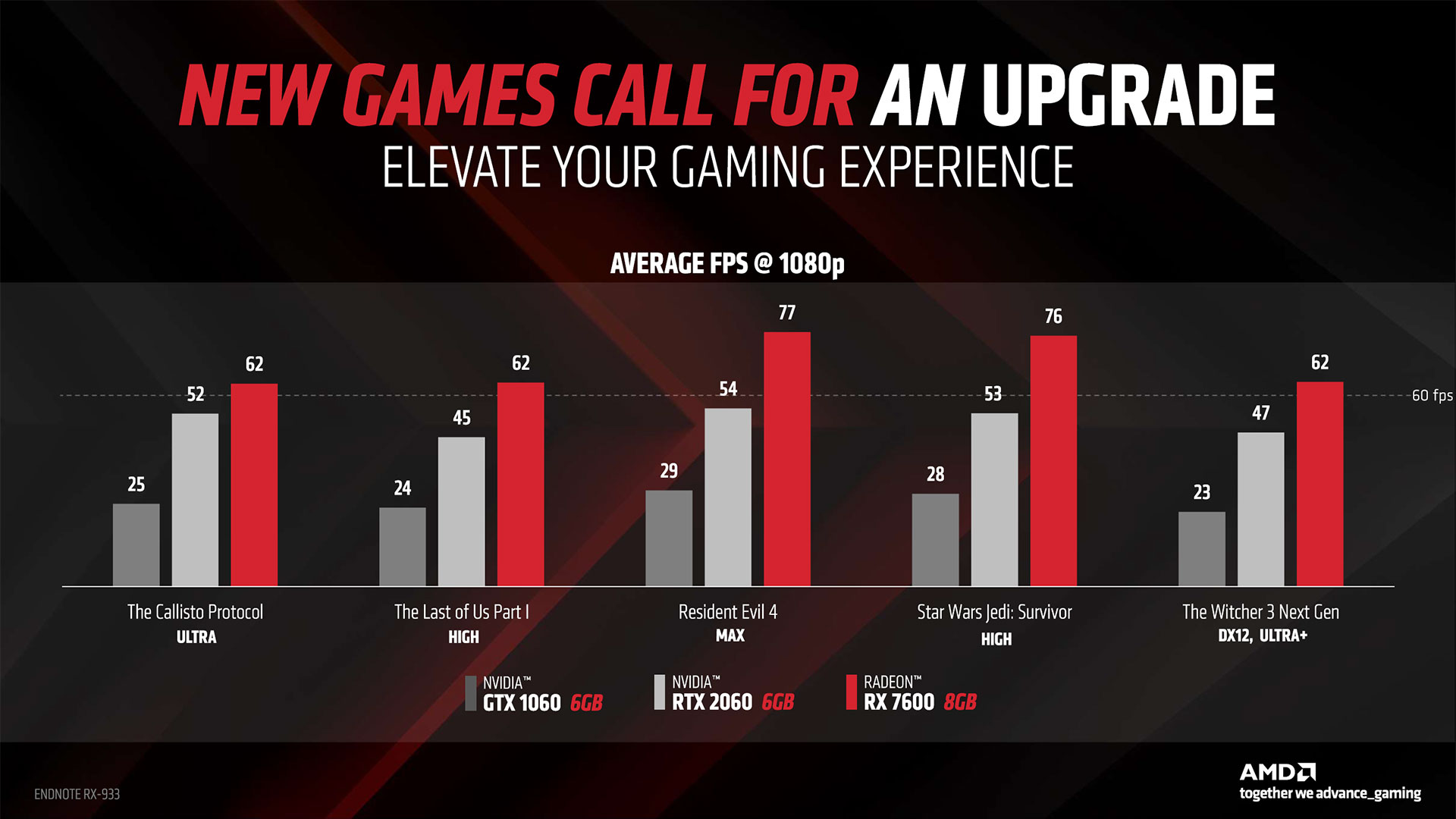








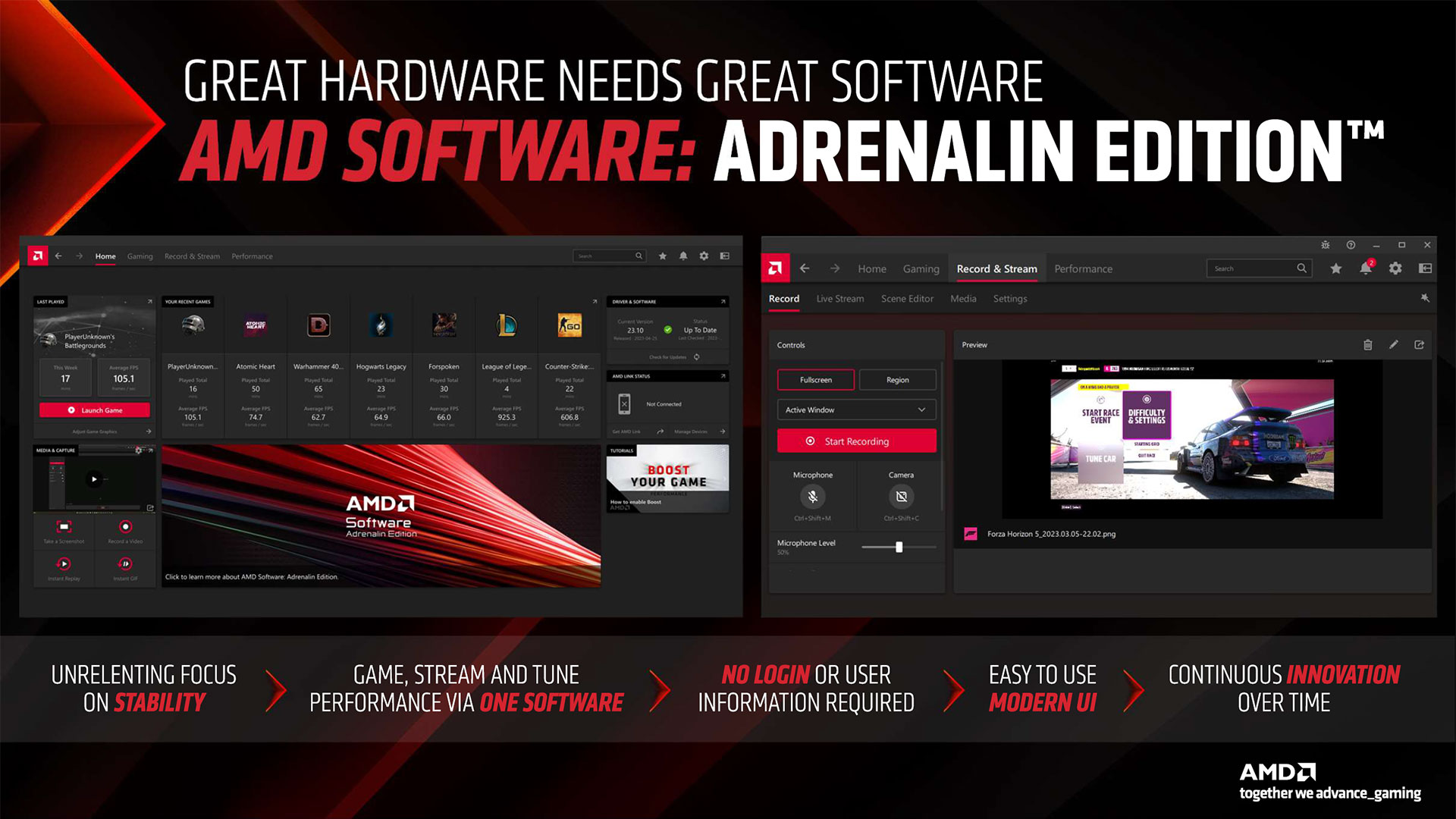
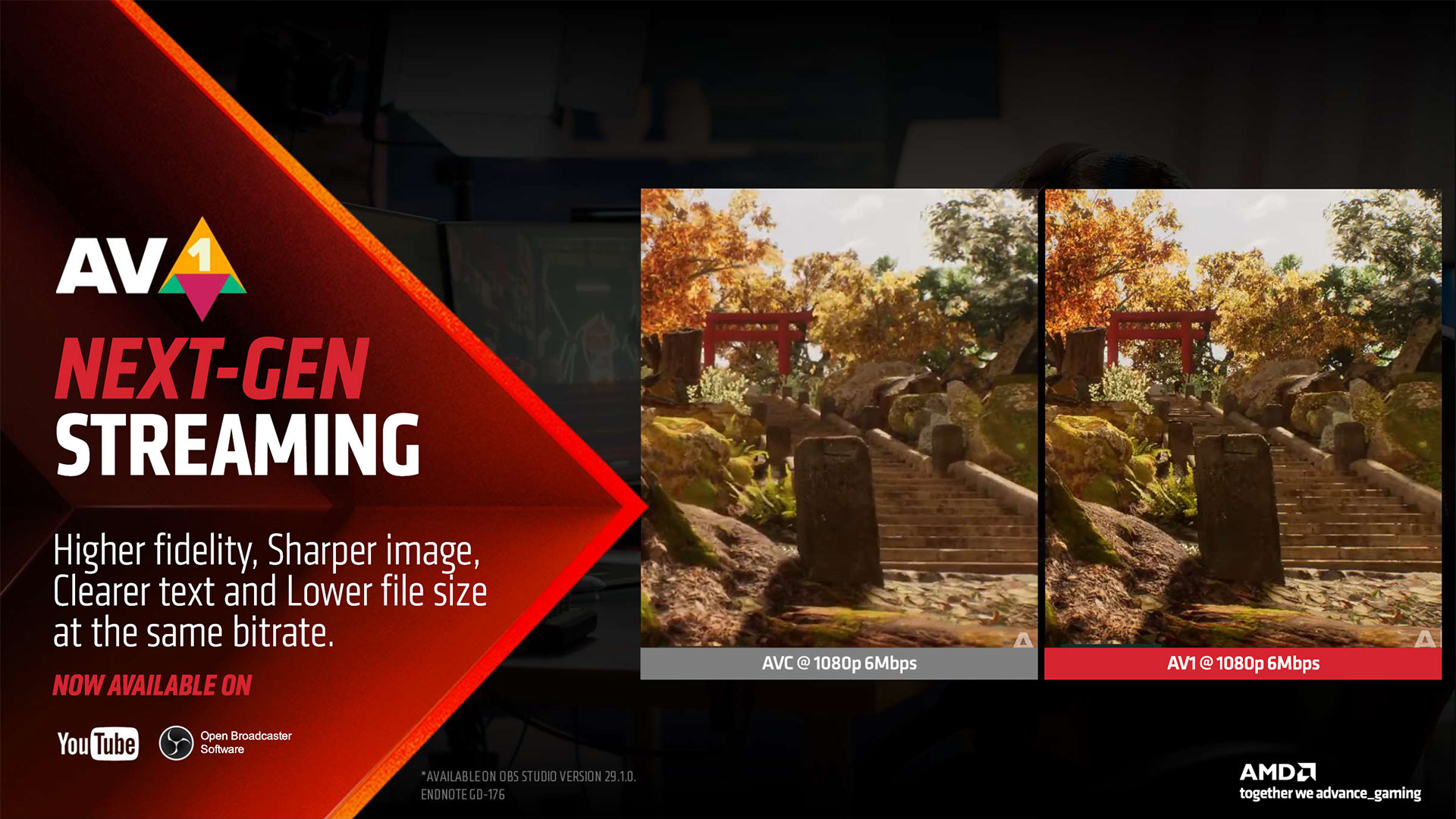
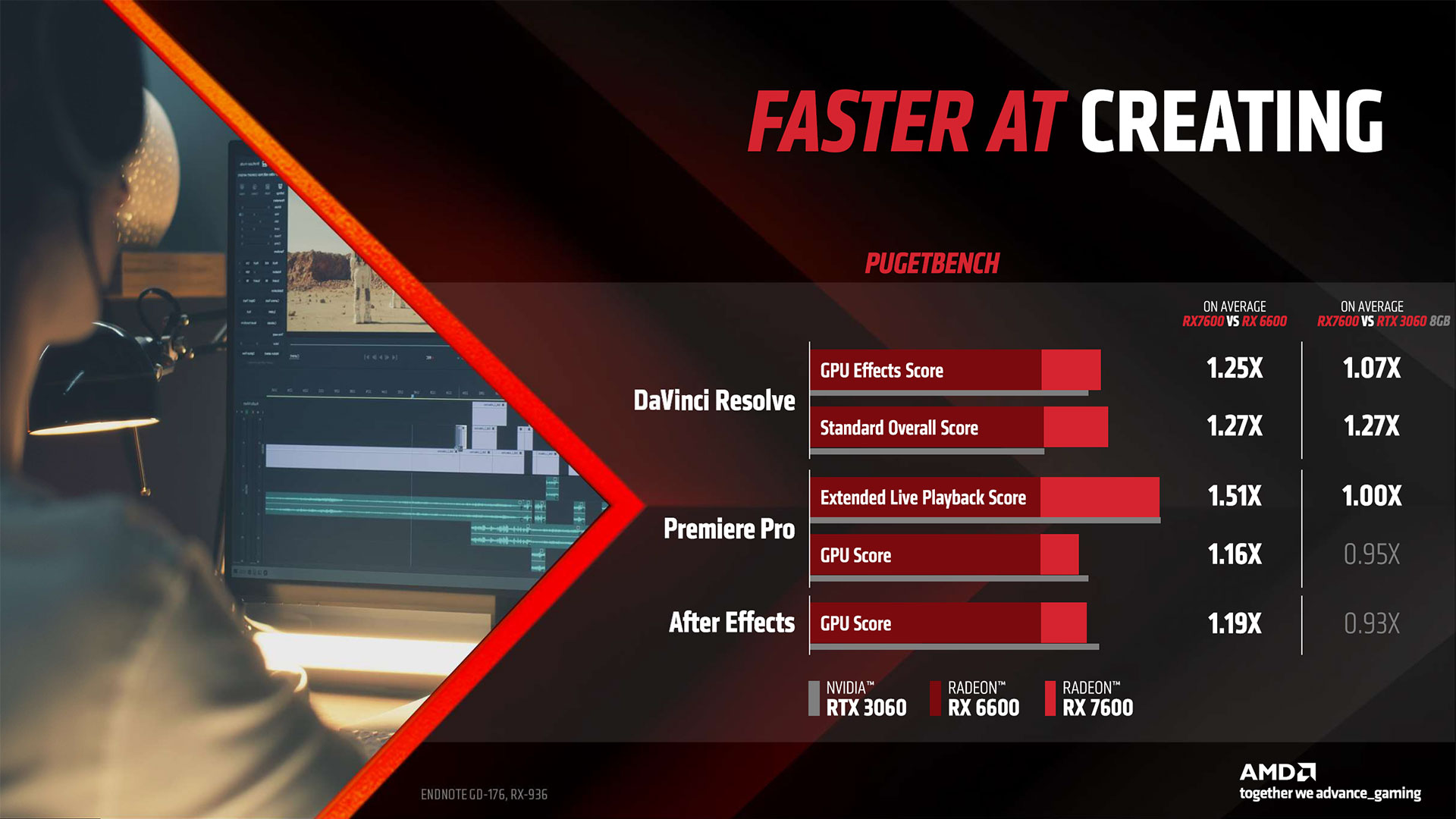








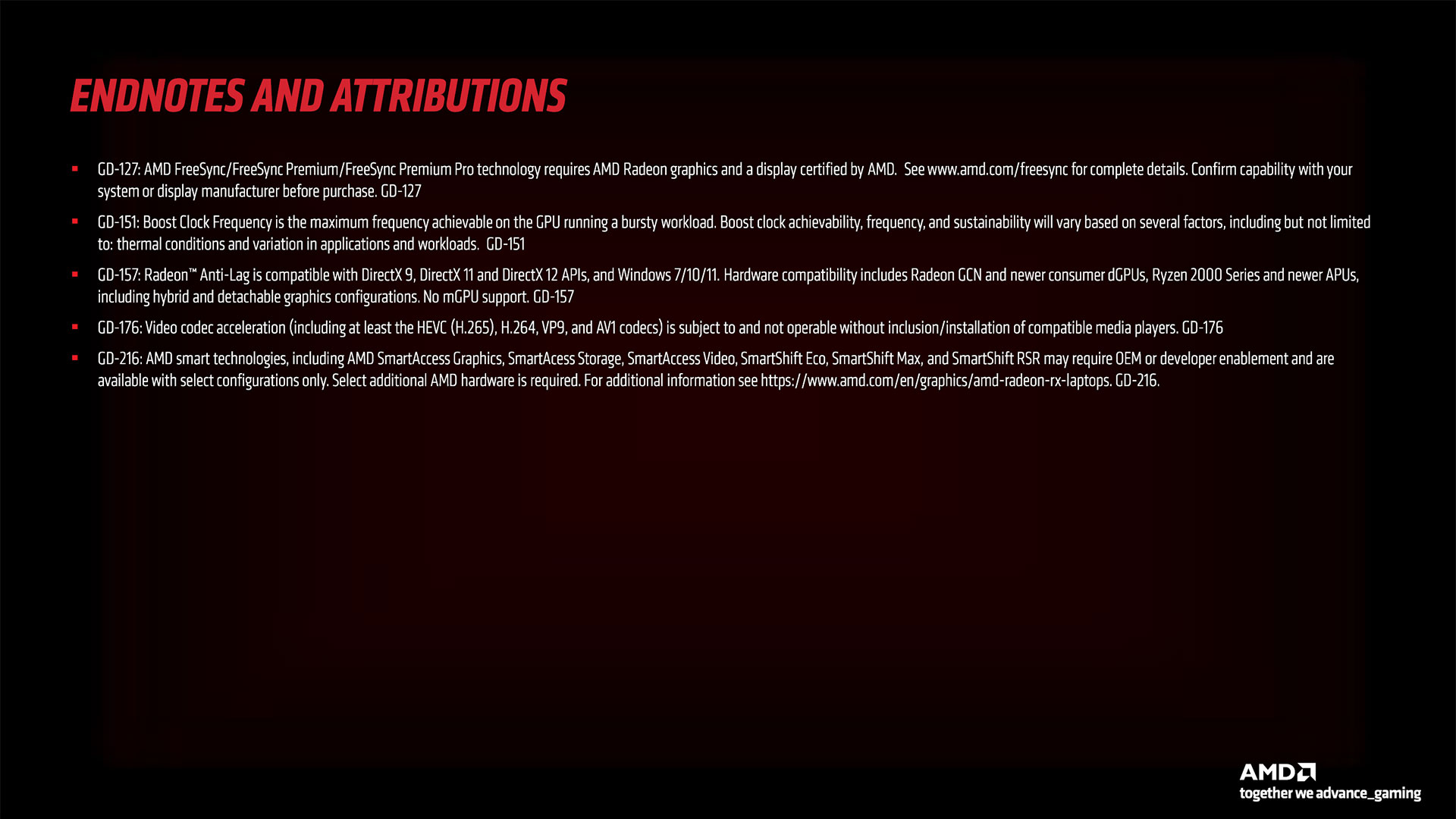

In case you're interested, here's the full slide deck from AMD's RX 7600 presentation for reviewers and analysts. There are some performance charts and various talking points, like the fact that the GTX 1060 is still one of the most popular GPUs, even though it's now seven years old.
The thing is, people using a seven-year-old GPU probably aren't even playing the latest games. Some of them might be using laptops as well. If someone hasn't upgraded in seven years, it's doubtful that the launch of a new $269 graphics card will suddenly spur tons of people to upgrade. But if you're in the market, it's good to have options, and that's exactly what AMD and Nvidia are doing with the RX 7600 and (upcoming) RTX 4060.
- MORE: Best Graphics Cards
- MORE: GPU Benchmarks and Hierarchy
- MORE: All Graphics Content
Get Tom's Hardware's best news and in-depth reviews, straight to your inbox.
Current page: AMD Radeon RX 7600 Review
Next Page AMD Radeon RX 7600 Reference Design
Jarred Walton is a senior editor at Tom's Hardware focusing on everything GPU. He has been working as a tech journalist since 2004, writing for AnandTech, Maximum PC, and PC Gamer. From the first S3 Virge '3D decelerators' to today's GPUs, Jarred keeps up with all the latest graphics trends and is the one to ask about game performance.
-
Amdlova As what I expected another pile of crap. One watt better than the old gen. Why spend sand on these... 199 dollar max for this graphics.Reply
@JarredWaltonGPU thanks for the review... hard time to you trying find somenthing good or new on these graphics -
salgado18 AMD should have made a refresh of the RX 6650 XT and earn more money. If nothing really improved, then what's the point?Reply -
btmedic04 Glad to see the last minute price drop, it definitely makes it a much more appealing product. Currently at newegg there are 5 rx 6650xt models available with an average price of $288 minus an average discount of $20. So more or less the same price as the rx 7600 mba. given that information, if I were in the market at that price range, I'd just grab the 7600 given they are more or less the same price once you factor in discounts. It still would've been nice to see a -600 class part match the last generation -700 class part in performance. Maybe we'll see that with a 7600 xtReply -
InvalidError Reply
While it may not make sense for people who already own something from the last generation or two, plenty of people have 5+ years old GPUs or are building new with no half-decent GPU to spare.Amdlova said:As what I expected another pile of crap. One watt better than the old gen. Why spend sand on these... 199 dollar max for this graphics.
I'm still using a GTX1050, waiting for something decent to hit ~$260 CAN. I bought an open-box A750 for $270 a few weeks ago, ended up returning it as seemingly defective since it caused my PC to crash repeatedly. -
Elusive Ruse Reply
People want a brilliant GPU and they wanna pay $250 for it, as if the whole pandemic, parts shortage and a historic inflation went over their head. This might sound like a radical idea, but mid-range starts at $500 now. :LOL:InvalidError said:While it may not make sense for people who already own something from the last generation or two, plenty of people have 5+ years old GPUs or are building new with no half-decent GPU to spare.
I'm still using a GTX1050, waiting for something decent to hit ~$260 CAN. I bought an open-box A750 for $270 a few weeks ago, ended up returning it as seemingly defective since it caused my PC to crash repeatedly. -
atomicWAR Reply
Should it though?Elusive Ruse said:This might sound like a radical idea, but mid-range starts at $500 now. :LOL:
